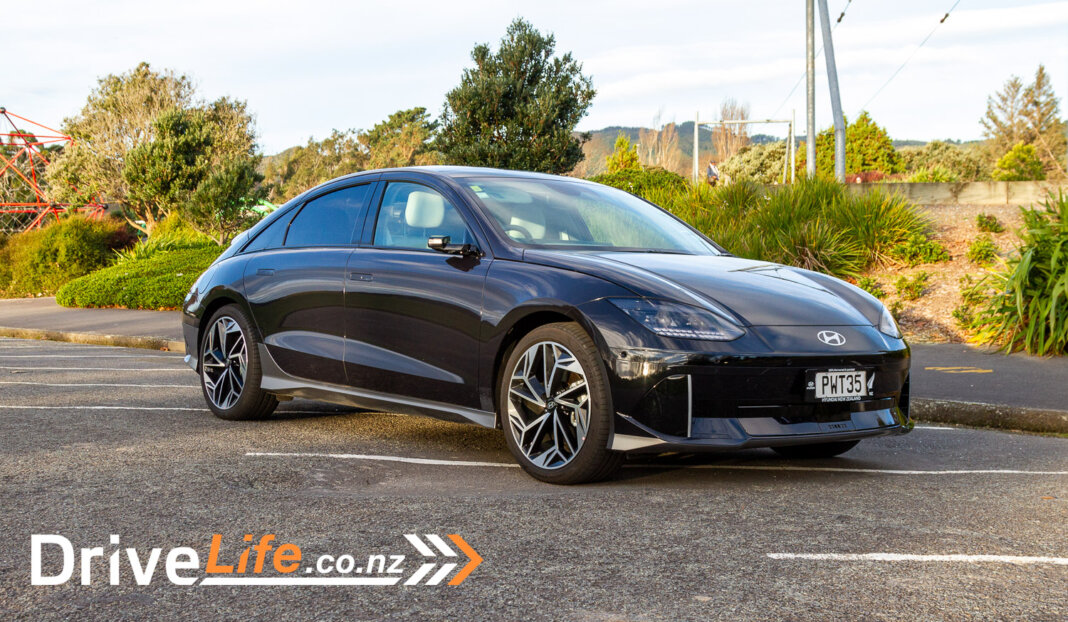World Car Of The Year 2023 is just one of the accolades that have been heaped on the Hyundai IONIQ 6 Limited AWD.
This coupled with “Electric Vehicle Of The Year” and “World Car Design Of The Year” honours gave the Korean brand a triple win for the second year in a row. Last year these same awards were taken out by the IONIQ 5. Quite an impressive feat and deserved recognition for just how well the brand is doing with their current product.
When I heard the IONIQ 6 keys would be available at the DriveLife office it was with mixed feelings. I’m not a big electric vehicle person but was excited to try it and see what all the hype was about. One hundred of the world’s most distinguished motoring journalists couldn’t be wrong, right? It must be good, but would I see it in the same light?
On top of that, it has been a while since a new sedan has passed through the office. Sedans are right up my alley and this was a refreshing change from the SUV’s that are becoming standard issue in New Zealand.
Read on to find out how my time in the electrified streamliner went.
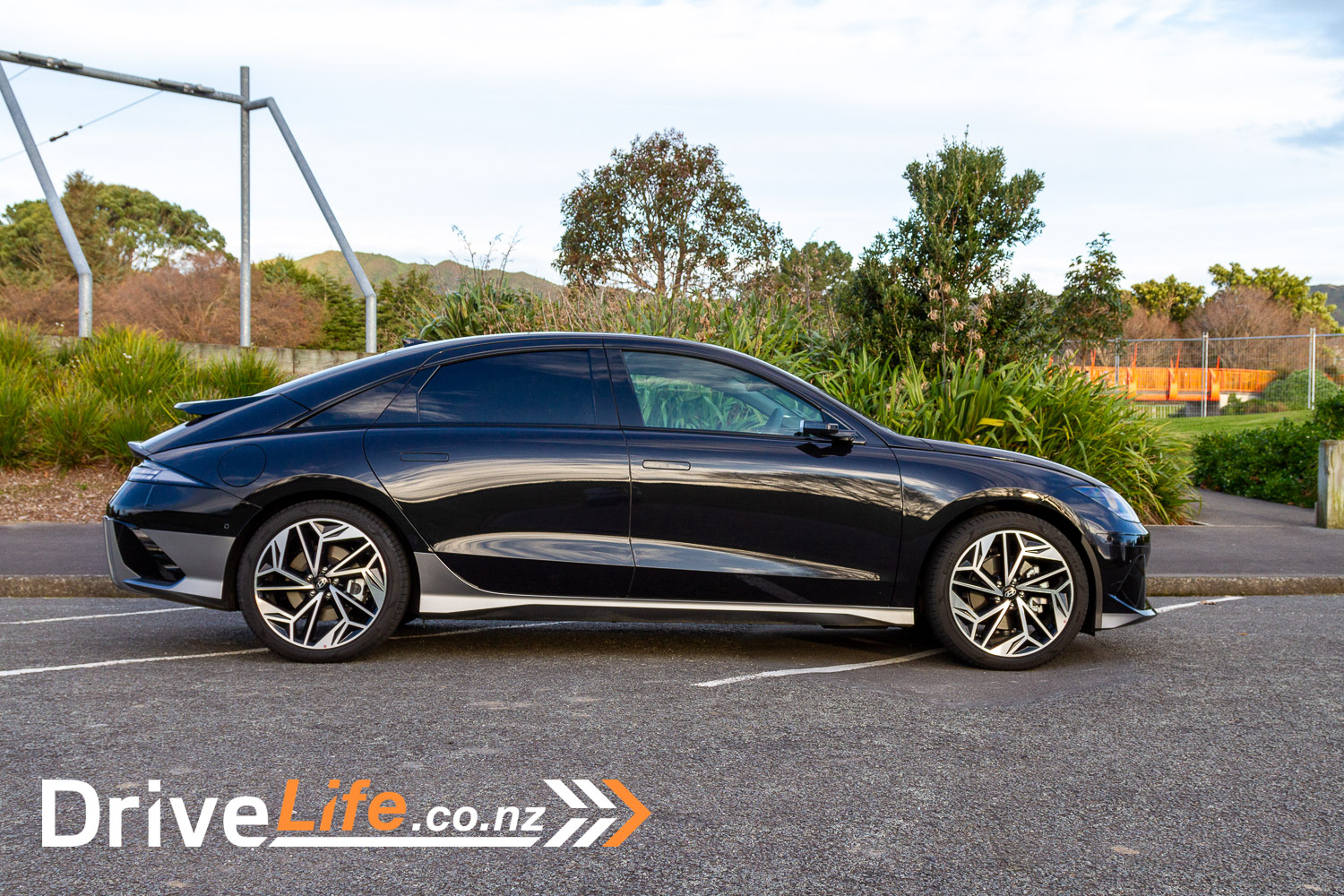
What We Like and Dislike About The 2023 Hyundai IONIQ 6 Limited AWD Limited AWD
| What we like | What we don’t like |
| Great interior styling Great HUD Comfortable and high quality seats Exceptional drive assist features Huge interior space for all | Cheap key fob Advertised range inaccurate |
What’s In The 2023 Hyundai IONIQ Range?
The IONIQ 6 comes in 4 versions. Starting at the bottom of the range, you have the IONIQ 6 53 kWh 2WD coming in at $79,990. This is the only version with the lower capacity battery and features a rear wheel traction motor that is carried across the entire range.
Moving up the range, the most noticeable change to the IONIQ 6 77.4 kWh 2WD is the upgrade to a bigger battery. In theory this gives an additional 185km range while everything else remains the same spec.
Next up, you have the IONIQ 6 77.4 kWh Elite 2WD. Here you start getting upgrades in specification, such as privacy glass, full leather interior, electric adjustable and heated seats, and technically a heat pump aircon system. You pay a 10% penalty in the advertised range for all these extras.
Last but not least, you have the top of the range IONIQ 6 77.4 kWh Limited AWD which is the version we had available to test. This has an additional front traction motor, adding another 74kW and 350Nm whilst again reducing the available range, this time to 519km.
When placing your order online, there are very few options available. First it is the battery size, 53 or 77.4 kW, then 2 or 4-wheel drive, followed by trim level. Trim can be either cloth, or if you prefer leather a choice of black or grey. However, it is not possible to get leather with the base 53 kW option, nor cloth with the Limited AWD version. Once through this, you get to select one of 8 colours, all at no extra cost.
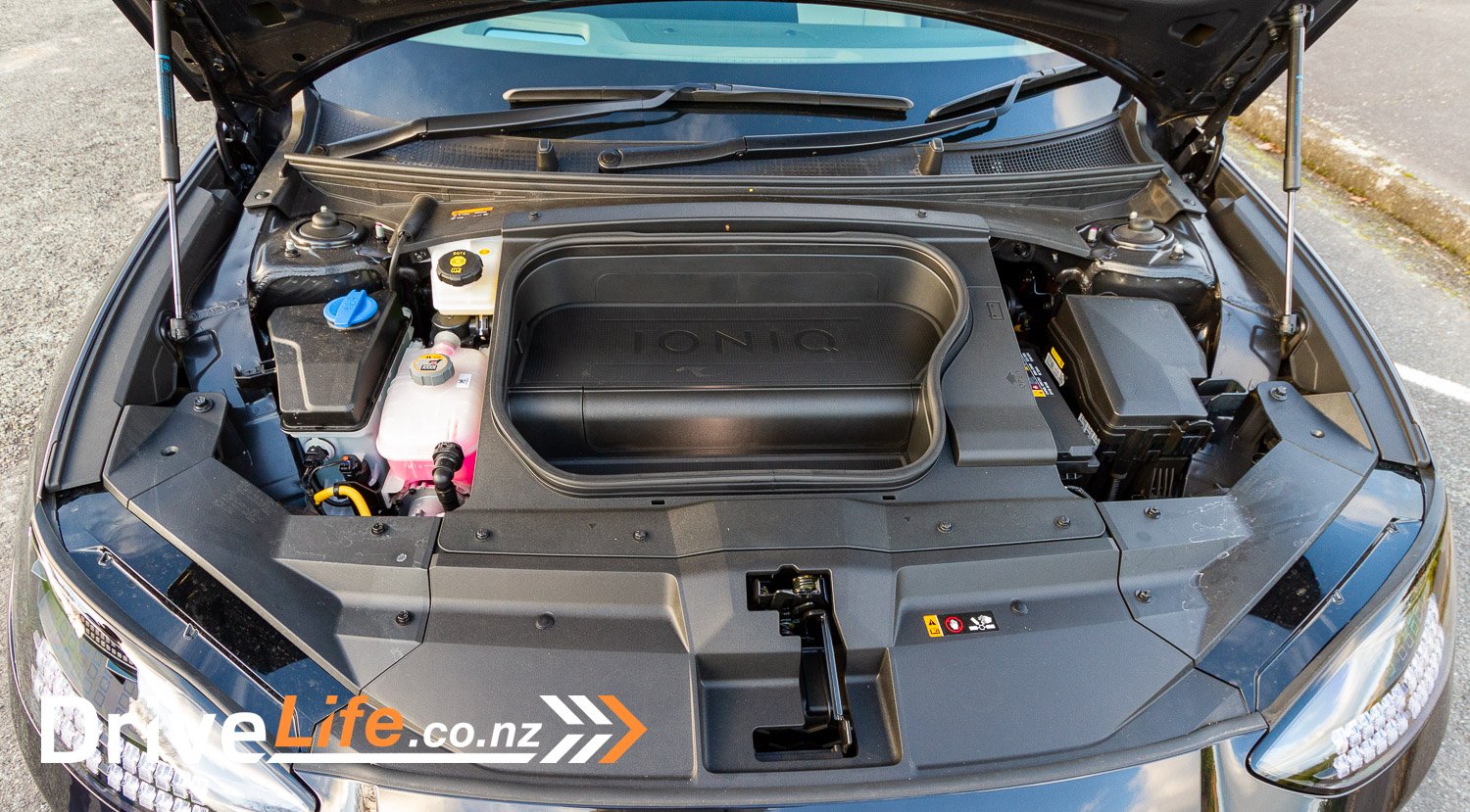
2023 Hyundai IONIQ 6 Limited AWD Standard Equipment Highlights
- 3 levels of brake regeneration including smart mode
- Paddle shifters for brake regeneration levels
- On Board Charger (OBC)
- Heat pump air-conditioning system
- Tyre Pressure Monitoring System (TPMS)
- Tyre Mobility Kit (TMK)
- Electronic Parking Brake (EPB) with auto hold
- Electric motor-driven power steering
- ABS braking with Electronic Brake-Force Distribution
- Brake Assist System (BAS)
- Electronic Stability Control (ESC)
- Traction Control System (TCS)
- Vehicle Stability Management (VSM)
- Blind-spot Collision Avoidance Assist (BCA)
- Blind-spot View Monitor (BVM)
- Rear Cross-traffic Collision Avoidance Assist (RCCA)
- Forward Collision Avoidance Assist (FCA 2) with Junction Turning (JT), Junction Crossing (JC) & lane charge side & oncoming avoidance
- Smart Cruise Control (SCC) with stop & go
- Lane Keeping Assist (LKA)
- Lane Following Assist
- 7 Airbags (dual front, side, curtain & front seat centre airbag)
- Electro Chromatic rear-view Mirror (ECM)
- Automatic dusk-sensing headlights
- Parking Collision Avoidance assist – reverse/forward/side (PCA)
- Remote Smart Parking Assist 2 (RSPA 2)
- Surround View Monitor (SVM)
- Power sunroof
- Power operated boot
- Digital Side Mirrors (DSM)
- Heated side mirrors
- Intelligent Front-Lighting System (IFLS)
- LED Daytime Running Lights (DRL)
- LED tail lights
- Rear spoiler with high-mounted LED stop light
- Privacy glass (rear doors and windows)
- Solar UV protection glass
- Full leather interior trim
- Leather steering wheel
- Driver 10-way electrically adjustable seat with ‘relaxation mode’
- Passenger 10-way electrically adjustable seat with ‘relaxation mode’
- Driver Integrated Memory Seat (IMS) system
- Heated front seats
- Heated rear outboard seats
- Ventilated front seats
- Heads-Up Display (HUD)
- Interior mood lighting
- Smart proximity key and EV start / stop button
- Keyless entry with anti-theft alarm
- Automatic opening flush door handles
- Hyundai Active Locking Operation (HALO) including speed-sensing auto door locking
- Apple CarPlay & Android Auto compatibility
- BOSE premium audio system with 8 speakers including subwoofer
- Bluetooth voice recognition hands-free phone system
- Dual-zone automatic climate control air-conditioning with pollen filter
- Automatic windscreen defog
- Trip computer including distance to empty, average energy consumption, average speed and outside temperature display
- 12.3″ colour full TFT driver information display
2023 Hyundai IONIQ 6 Limited AWD Color Options
- Abyss Black Pearl
- Ultimate Red Metallic
- Gravity Gold Matte
- Serenity White Pearl
- Byte Blue
- Digital Green Pearl
- Biophilic Blue Pearl
- Nocturne Grey Metallic
2023 Hyundai IONIQ Optional Equipment
- Wall Box Charger – IONIQ 6 + $2242.50
- Vehicle to Load (V2L) Adaptor + $862.50
Our review car included the Vehicle to Load Adaptor, an additional $862.50 giving a retail price of $125,852.50
For a full list of specs and options available for the Hyundai IONIQ 6 head on over to the Hyundai New Zealand website
How Does The 2023 Hyundai IONIQ 6 Limited AWD Compare To Its Competition?
Having been awarded World Car Of The Year 2023, you would expect it is hard to find comparisons and this definitely is the case. Nevertheless, the following examples show where the IONIQ 6 Limited AWD fits within some of its competition..
All prices below exclude the refund or additional cost of the New Zealand Clean Car Programme.
| Make/ Model | Battery Capacity kWh | Power/ Torque kW/Nm | 0-100km/h seconds | Range (WLTP) | Boot Space, litres | Price (excl CCP) |
| Mercedes-AMG EQE 53 4MATIC | 90.5 | 484/950 | 3.5 | 500 | 430 | $195,500 |
| Hyundai IONIQ 6 Limited AWD | 77.4 | 239/605 | 5.1 | 519 | 423 | $124,990 |
| Kia Ev 6 Gt Line (AWD) | 77.4 | 225/605 | 5.2 | 484 | 490 | $111,990 |
| Polestar 2 Long Range Dual Motor (AWD) | 78 | 300/660 | 4.7 | 480 | 405 | $104,900 |
| Tesla Model 3 Performance (AWD) | 75 | 377/660 | 3.3 | 547 | 651 | $103,900 |
First Impressions Of The 2023 Hyundai IONIQ 6 Limited AWD
When I first saw the IONIQ 6, I didn’t quite know what to think. It was obvious that a lot of thought had gone into the design and it was very refined, but different angles of view give a completely different aesthetic and sense of the vehicle.
The front three quarter can look strange with a very low sloping rear and high front showing a lot of ground clearance. Moving to the rear three quarter, it looks a lot more balanced and resembles a Nissan 300ZX. When you look directly from the rear, it is pure Porsche 911 with huge rear flanks. Whatever your take, it looks well designed, well thought-out and slippery, an essential thing for a modern electric vehicle.
My favourite view was from the rear, probably for the 911 vibes, but over time the whole vehicle’s external look grew on me.
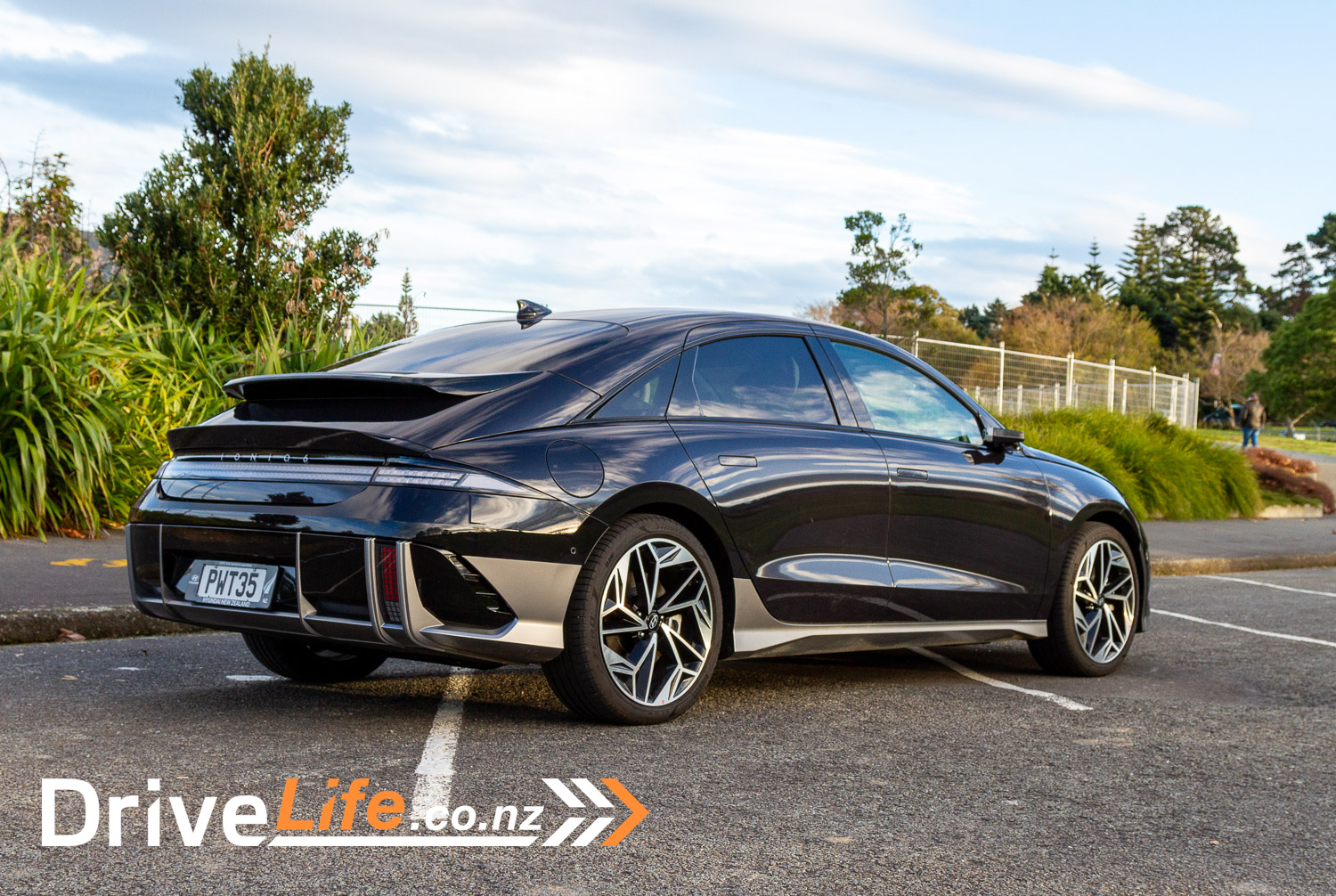
Our test model came in Abyss Black Pearl, coupled with the grey leather interior, a very sophisticated and elegant look. One thing that was apparent is that it is a big car, and it feels like this when inside. Huge 20” wheels only cement this feeling.
What’s The Interior Like In The 2023 Hyundai IONIQ 6 Limited AWD?
To open the door, you need a key fob, and unfortunately this is the one area that Hyundai totally missed the design on. It looks cheap and tacky for what is a pricey vehicle, and does not gel with the overall package of the car.
If the exterior is not quite your thing, never fear because the interior is pretty stunning. Upon opening the door the first thing you notice is the beautifully clean lines and an abundance of space. Hyundai have done a really nice job here. Going for a minimalist and clean design on any product takes a lot of skill, thought and care. It can easily go wrong and look not finished or complete, but in this case it all works and creates a really nice space with a very calming aura.
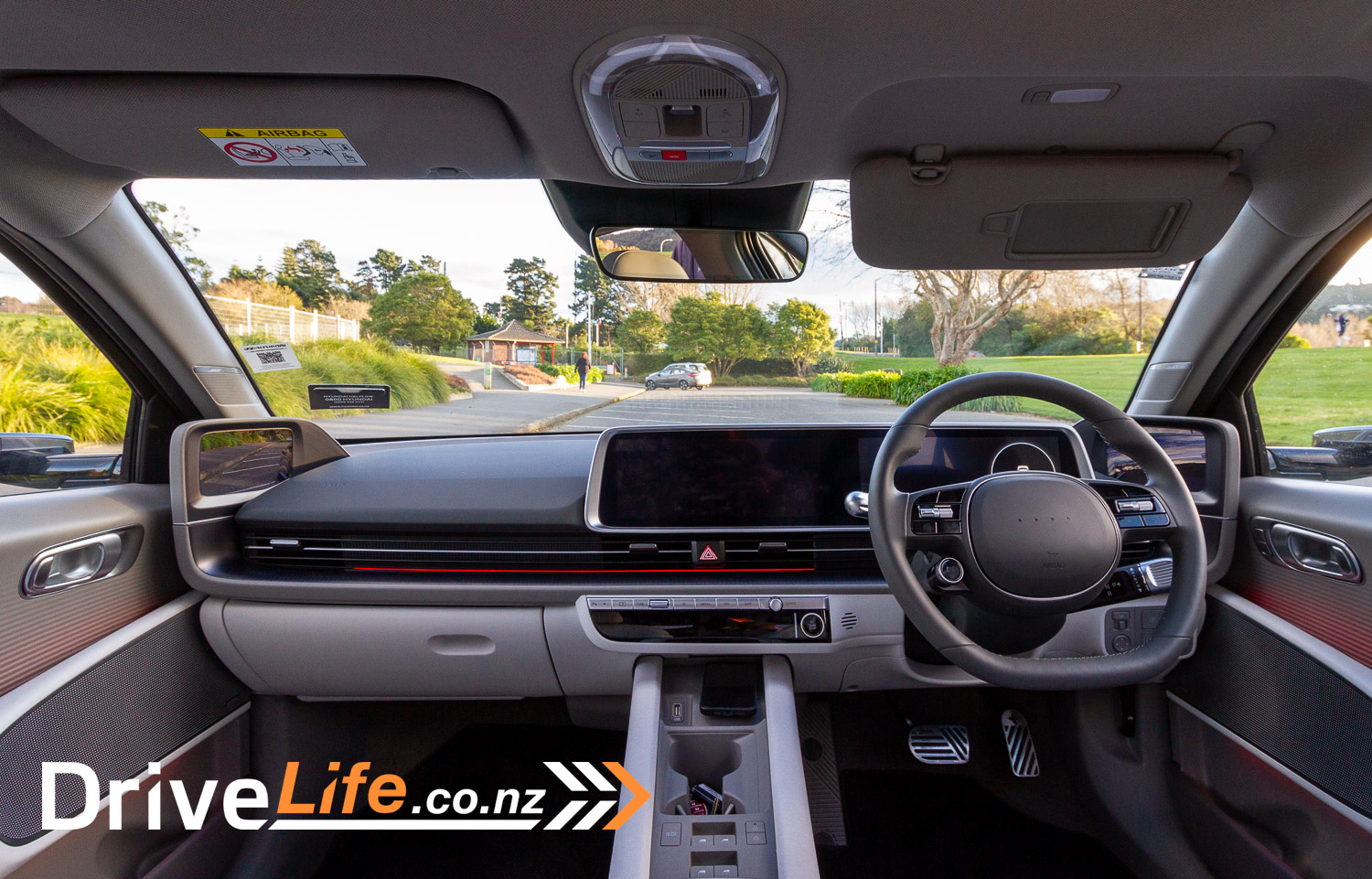
Climbing into the driver’s seat confirms this is a big car.
When getting acquainted with a new vehicle, the first thing I start looking at is the driving controls, and here you are not disappointed. In front of you is a very clean and simple, grey leather, flat-bottomed steering wheel. The diameter is a good size and the grip size works well for my hands. In terms of on-wheel controls, these again are clean and simple. Each side has 4 plastic buttons and both a tilt and vertical rotary wheel. On top of that, there is a circular push button on the lower left that allows you to change drive mode. The steering column contains two stalks, the right of which contains the drive modes and the left indicators and wipers etc. Adjustability is good and I had no problem getting everything comfortable.
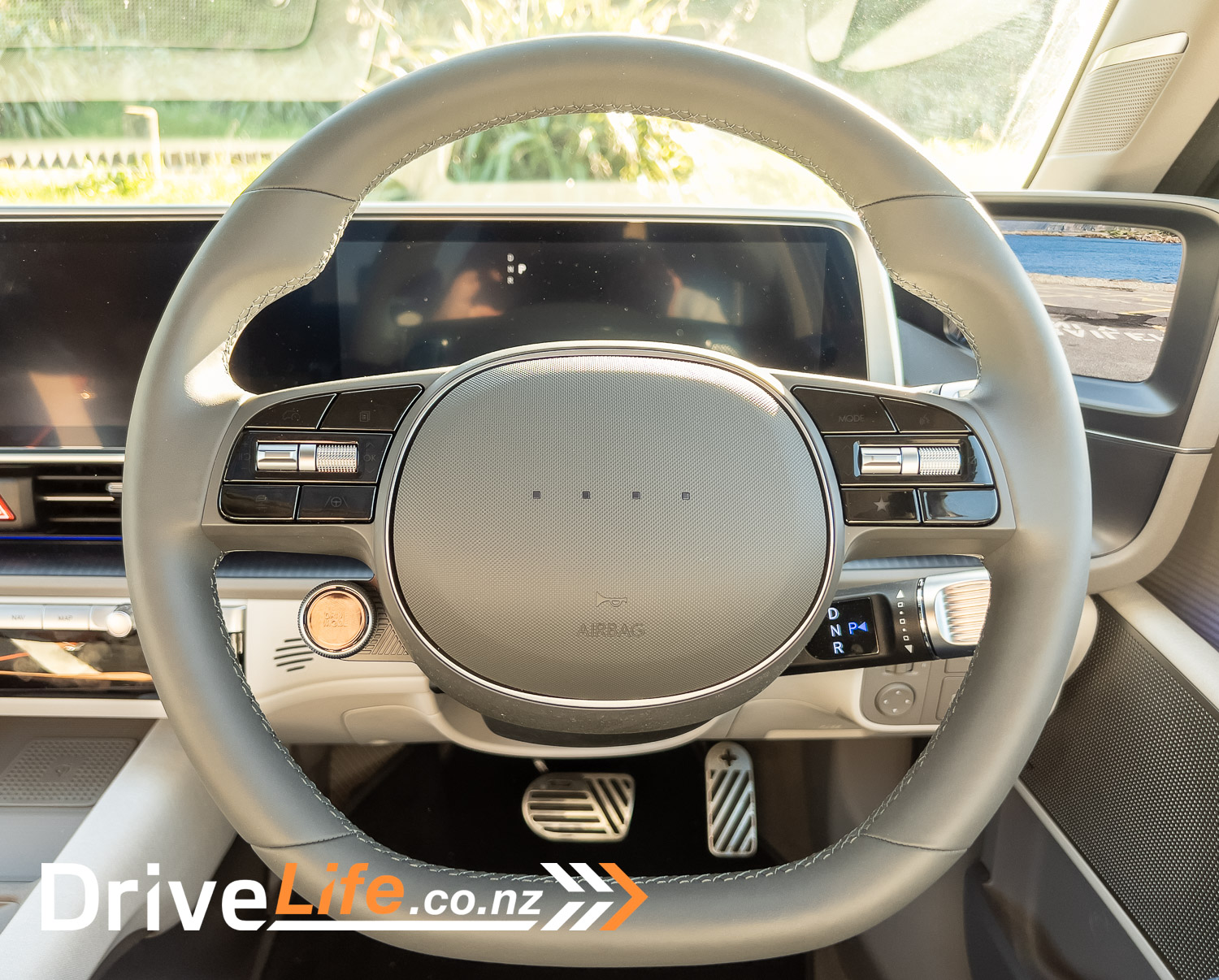
Speaking of comfort, the seats were a particular highlight. Our vehicle featured the 10-way adjustable seats for both the driver and passenger in grey leather. Over the week I took a variety of passengers and the one continual comment was how comfortable these were. I was easily able to get in a good position and the slide back function upon entry and exit worked perfectly. The leather, whilst being plain overall, featured attractive small perforated holes in the cushion and back, essential for the vented seats, and a nice look and texture.
As you would expect from a top-of-the-line electric vehicle, there is very little in the way of manual buttons, with everything being controlled via the touch screens. Directly in front of you is the 12.3” instrument cluster, with a variety of pages, and to the left another 12.3” TFT screen that controls the infotainment. Sitting side by side they give the illusion of a single screen, with just a thin black vertical black space between. Underneath the infotainment screen you have the hazard lights button, slim and wide air vents, a thin line of buttons which have quick controls for certain features, and another thin LCD that shows predominantly air conditioning information. And that’s all you have in terms of a traditional dashboard. Behind the LCD screens, is a surprisingly small and minimalist dash. A lot of cars look like the screens are an added afterthought, but in this design they actually work really well and contribute to the great interior design.
One thing very noticeable on the dashboard is the two OLED digital rear-view mirrors. Positioned at the extremities of the dashboard, they have a parallel lower line that goes across the dash and curves up to the screen. This design element didn’t quite work for me, whenever I looked at it it reminded me of the wingtips on an A350 plane and I never really got this image out of my mind. This was one of only three design elements that didn’t hit the mark for me, the others being the fly-by-wire gear selector stalk, and that key fob.
Separating the driver from the passenger is a high centre console in a unique design. The top features cup holders, wireless charging pad, USB-C connector, electric mirror buttons and the auto-hold park-brake button. To the rear you have the traditional armrest and storage box, featuring another 2 internal USB-C plugs. Where this centre console is really cool is underneath, where you have a great storage container. It is a large space that can be used to store many items, in our case my wife’s purse, and makes use of an area that is normally inaccessible in a conventional ICE vehicle. This is something I have not seen before and proved really useful, another nice design touch.
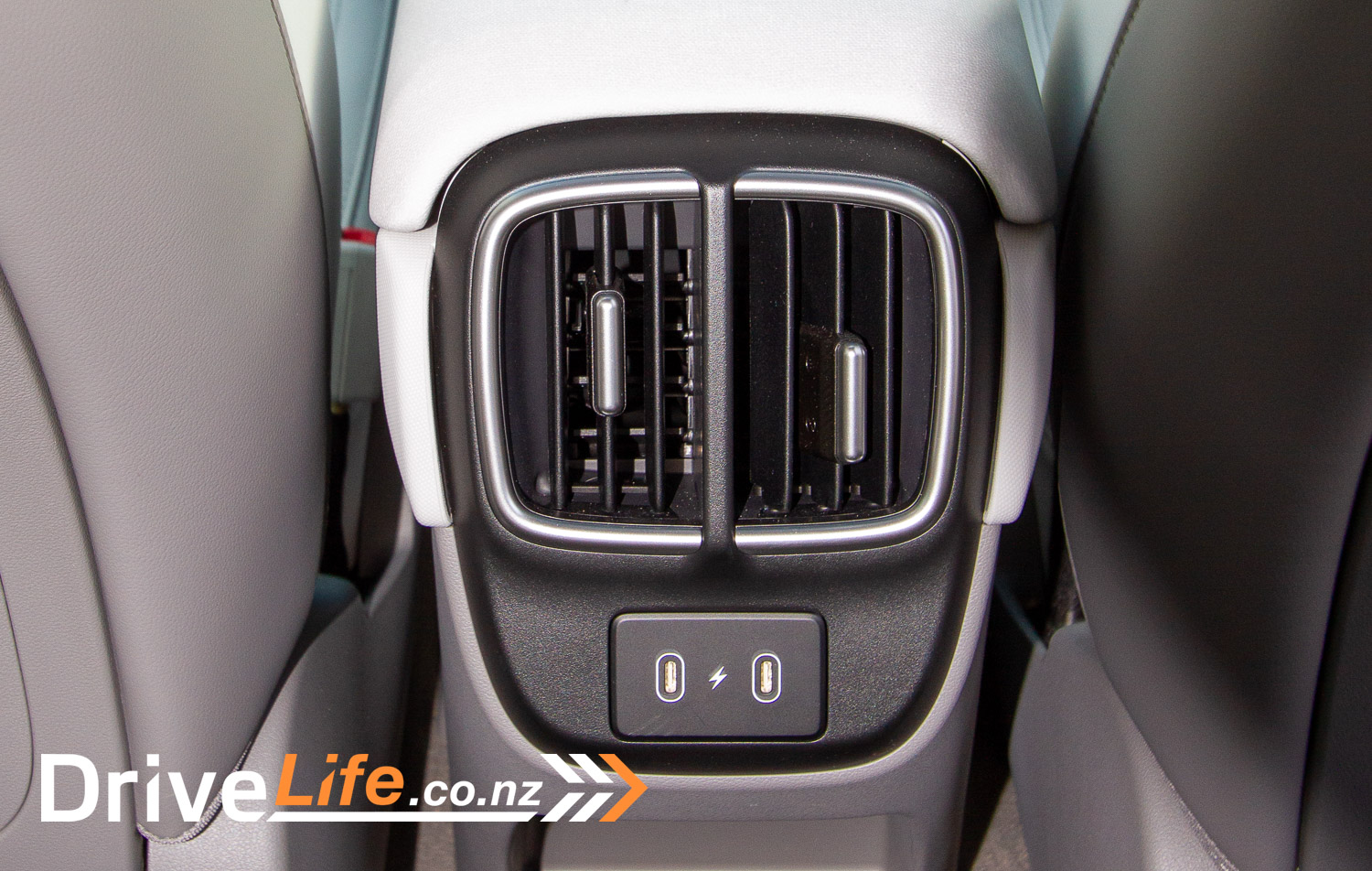
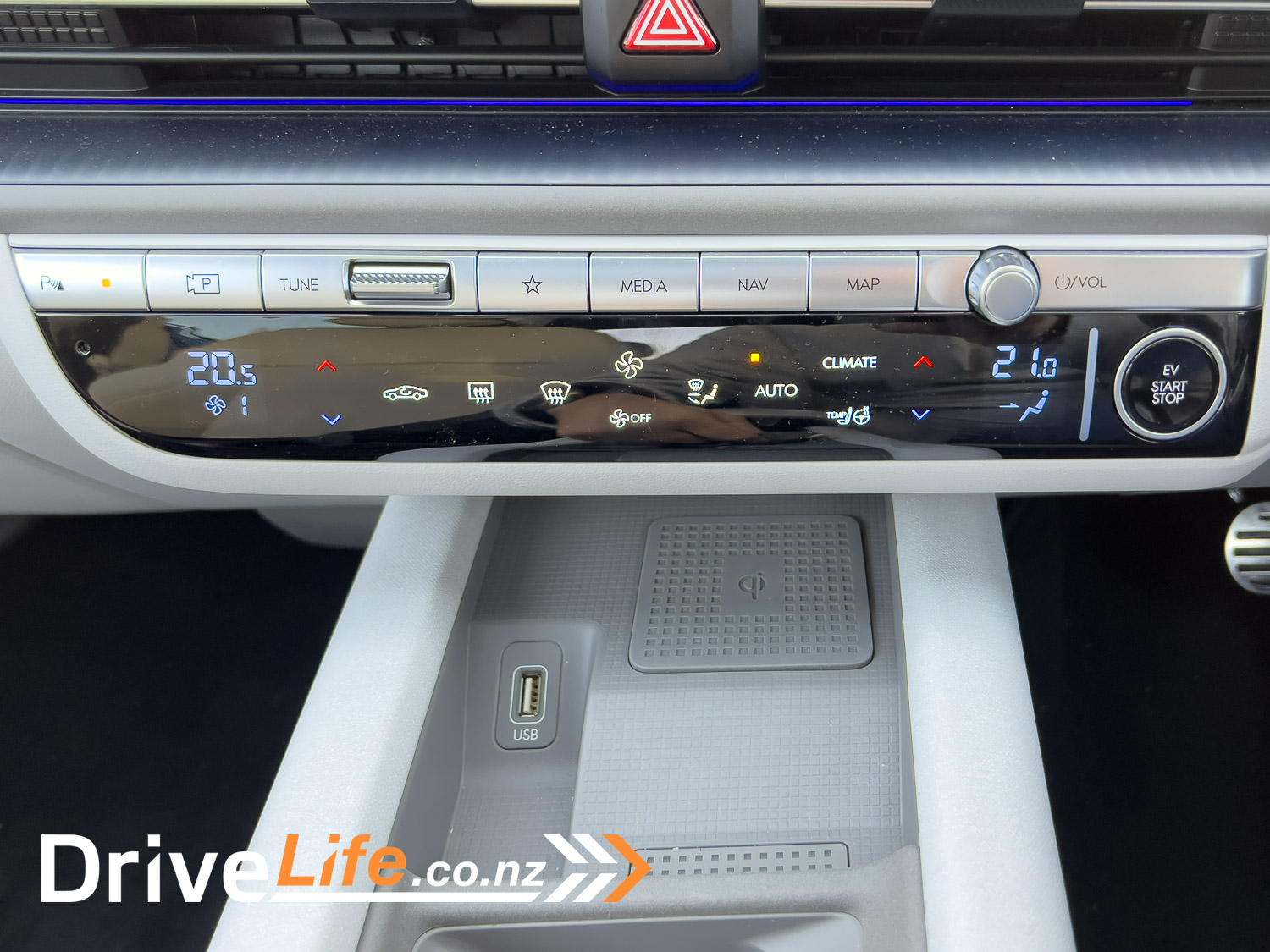
If the driving area sounds good, the passengers are also not neglected. Up front you have the same 10-way adjustable seat with relaxation mode. This involves the seat reclining to an almost lie-flat position, which combined with the multiple massage modes proved to be extremely useful for those charging stops that are part and parcel of electric vehicle ownership. Strangely however, this is activated from buttons high up on the right side of the passenger seat, making it really awkward to operate by the passenger. The normal glove box is actually a slide-out version, as opposed to the swing-down normally found. In theory this sounds great, and it is pretty decent sized, however a very large owner’s manual makes it pretty redundant in actual usable storage.
Back seat passengers are well catered for. Large, comfortable seats and an enormous amount of legroom resulted in my parents being perfectly happy spending a fair amount of time back there. Despite the sloping roof line, headroom was never an issue. You also have multiple vents for air and even more USB-C points. An adjustable headrest and a generous fold-down centre complete the space.
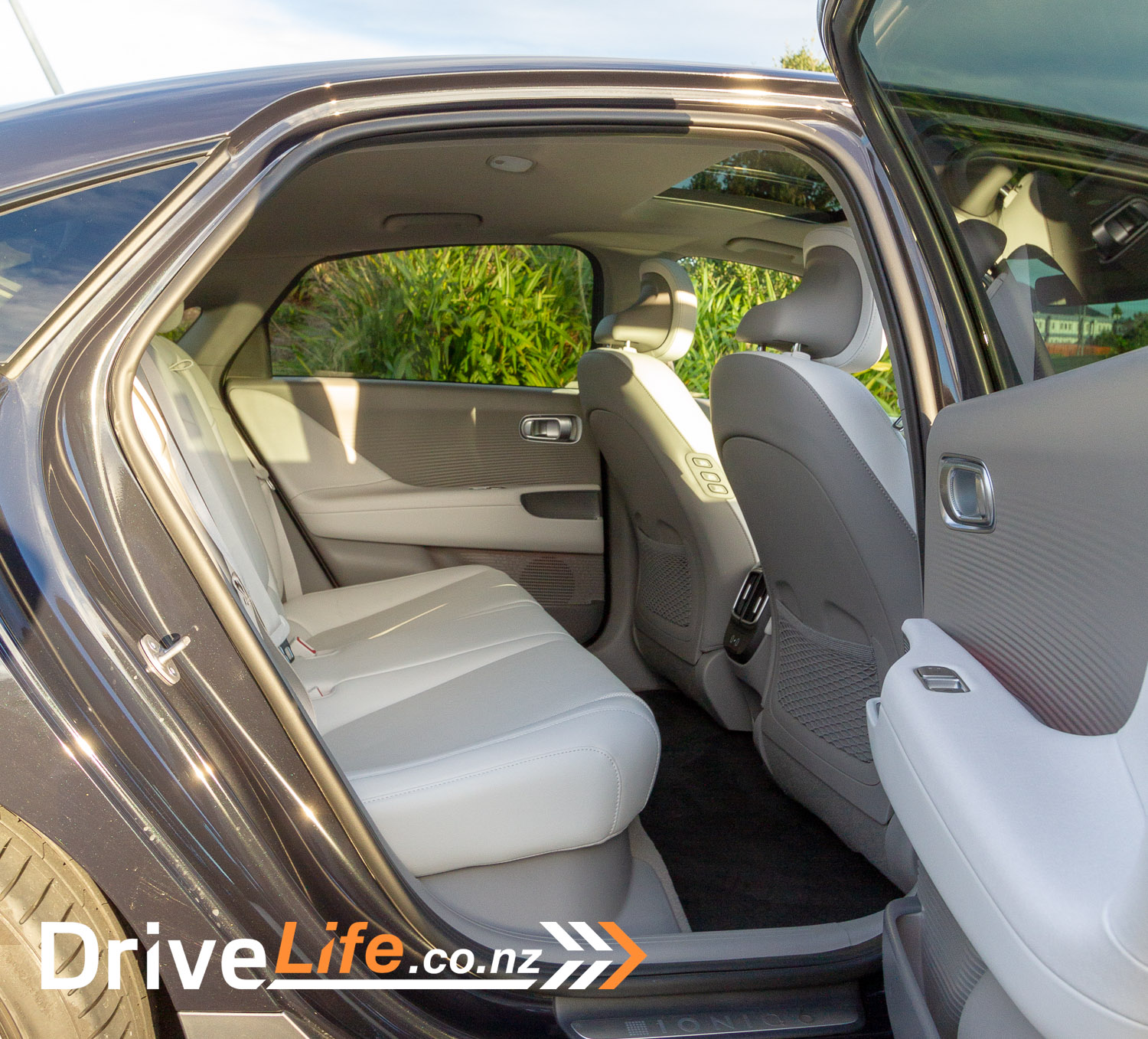
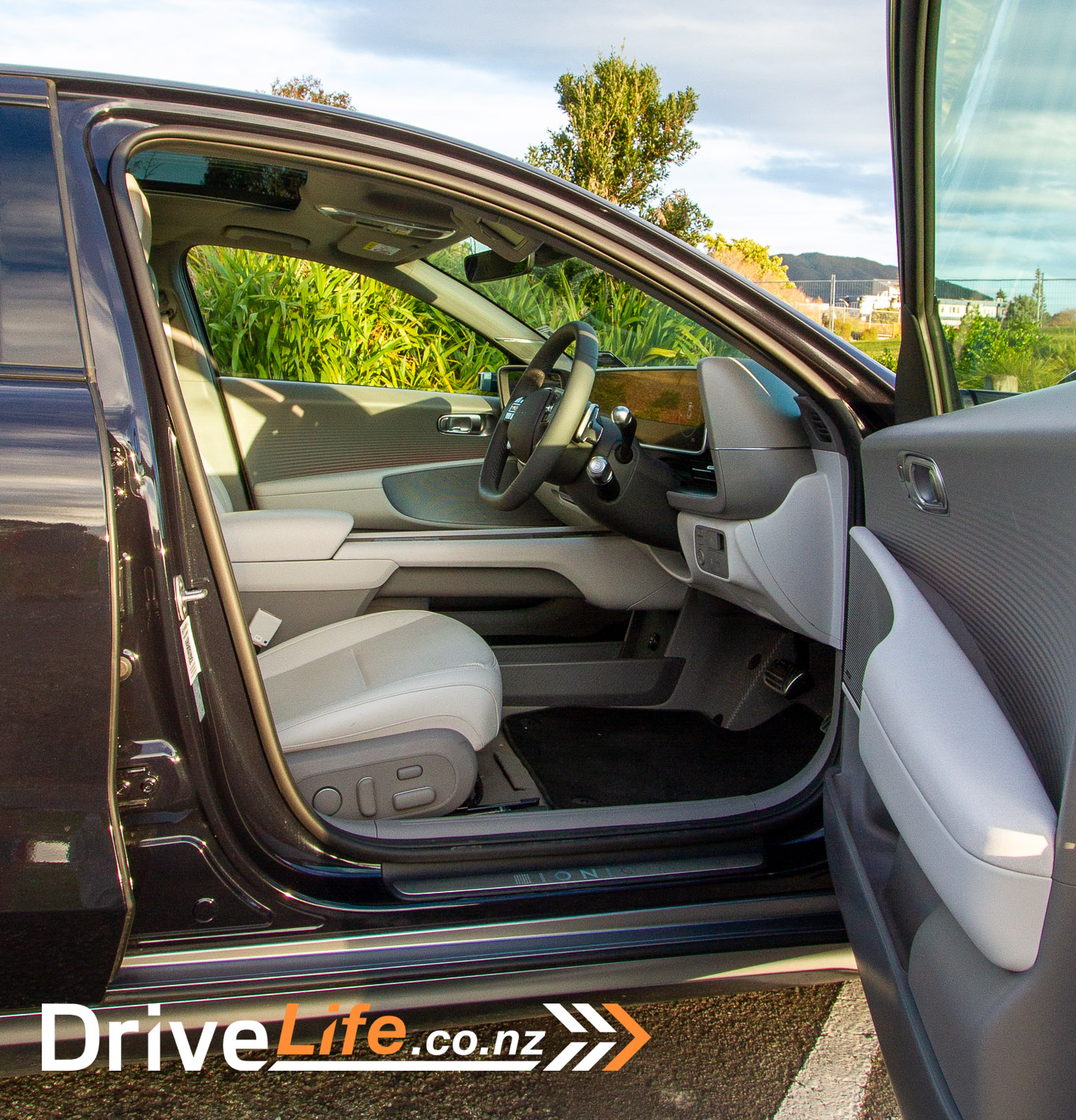
The front and rear door cards are relatively simple with the majority of the material, especially on the upper, being a nice plastic. A ribbed pattern gives a nice effect when the internal mood lighting shines over it, of which you have virtually unlimited options of colour. All doors feature Bose speakers which are nicely integrated. In a few of my reviews I have said that I’m not an audiophile, but this system sounded really nice when going.
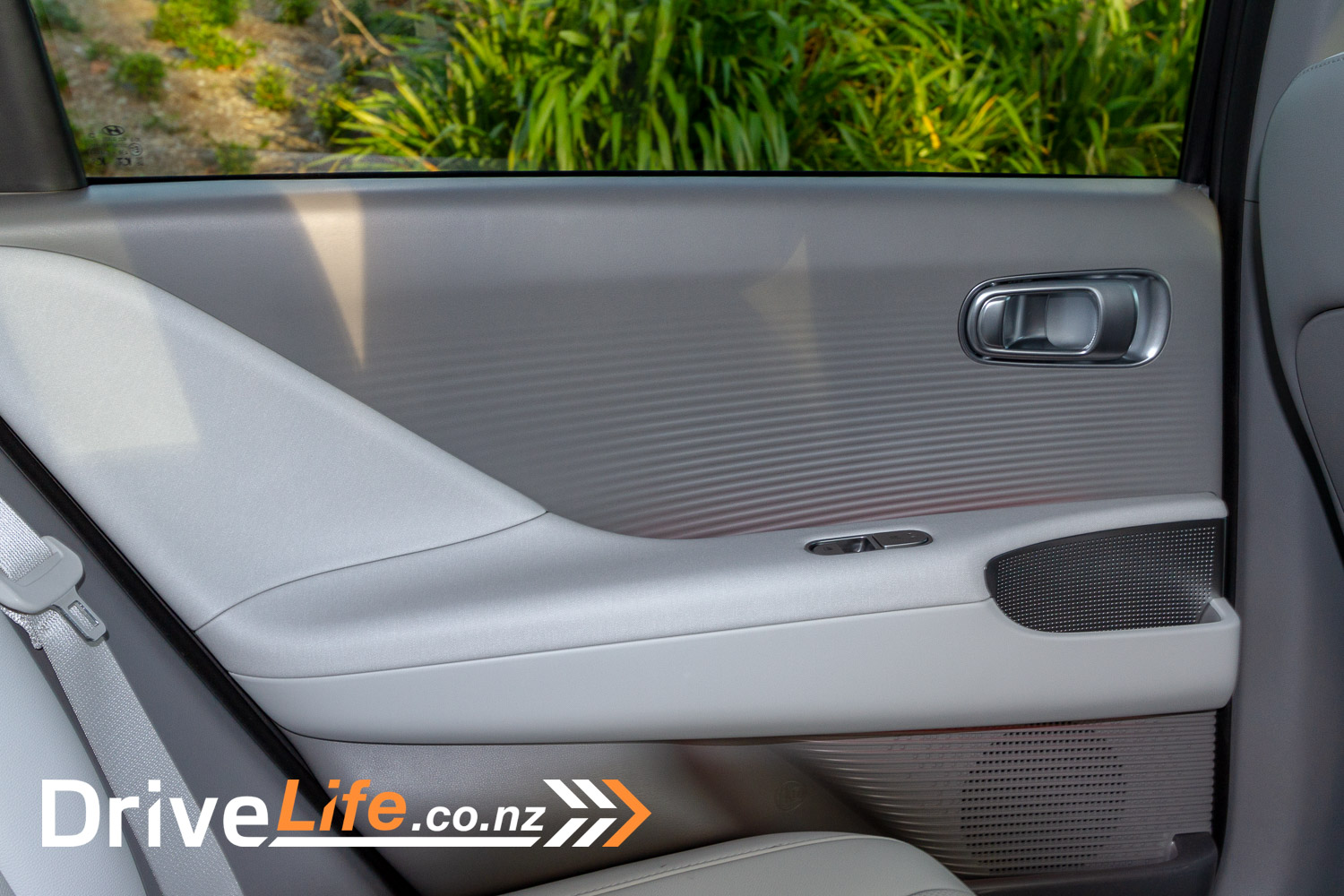
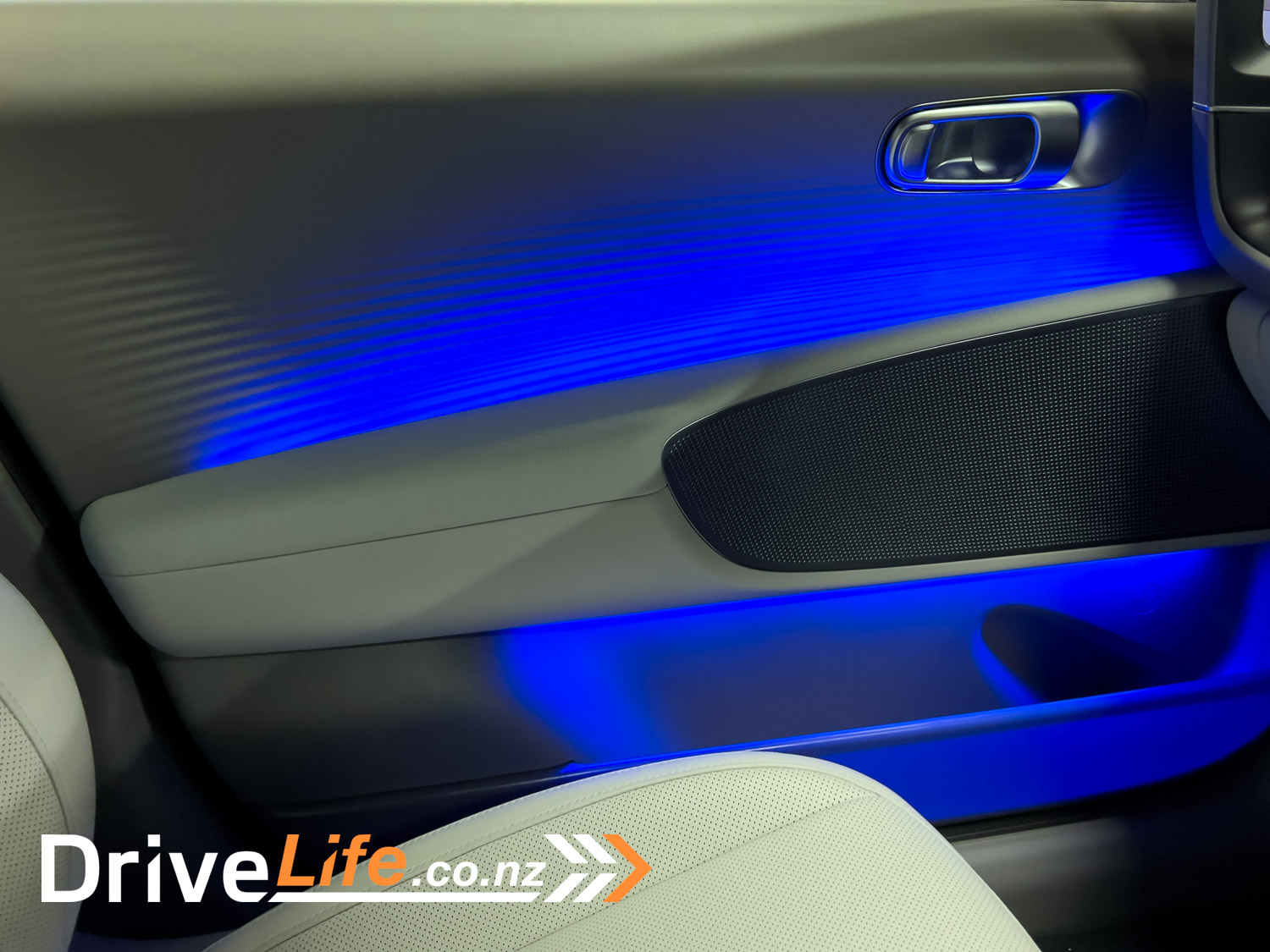
On paper the boot is not that big, but in reality we had no trouble fitting everything we needed for a couples weekend away. A quick trip to the airport where I easily fitted my wife’s luggage from a month overseas in the boot, appeased any nerves about the size of the boot. Its measurements are not that big, but you fit a lot in. The associated charge cables do take a lot of space when not tucked nicely under the false floor. Folding down the rear seats will increase the volume, and these are activated by pull tabs from within the boot, as opposed to the norm of some form of button on the upper rear seat. Initially I thought this was really inconvenient, but can see the point if you are loading the boot and need to access the extra space.
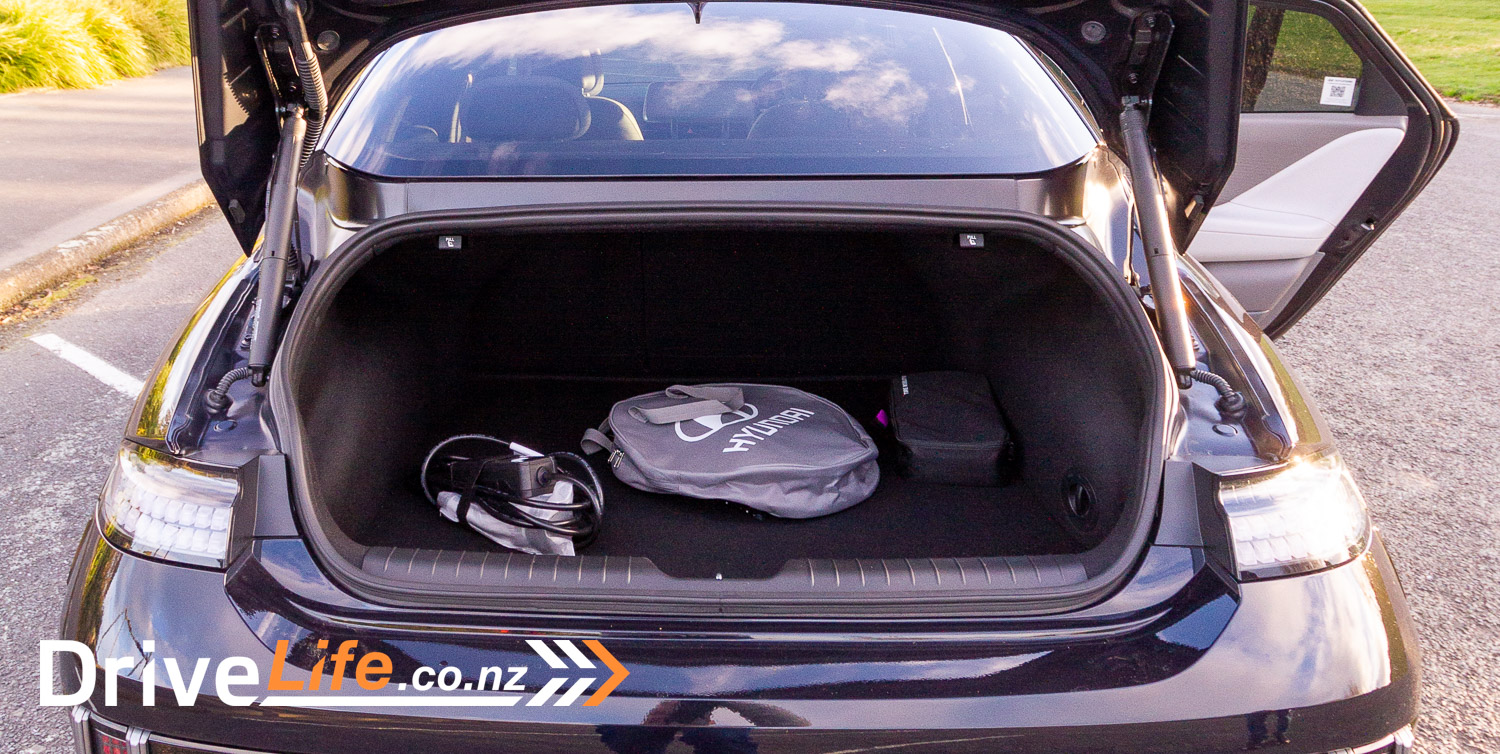
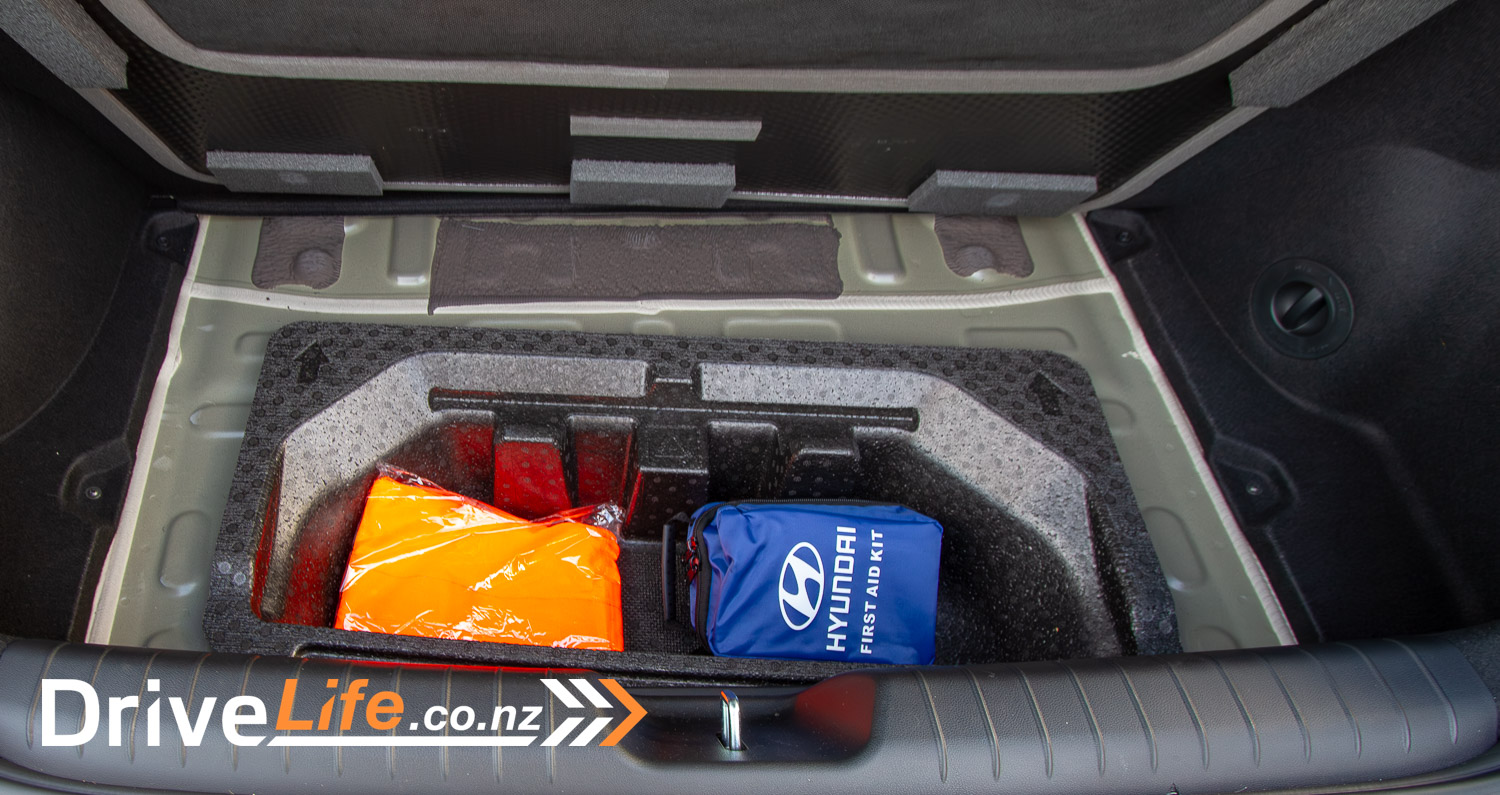
Overall a really nice interior. It looks great, is well constructed with high-quality materials and thoughtful design, and all well as intended. There are a couple of tiny things that you wonder why, but really there is nothing to be disappointed about here. Nice work, Hyundai design team.
What’s The 2023 Hyundai IONIQ 6 Limited AWD Like To Drive?
My first trip in the vehicle was to pick up Dad and go on a photo shoot – a quick drive through the suburbs on a weekend afternoon.
As mentioned above it is a big car, and it feels like this when you are cruising around. While it is a heavy vehicle (coming in at 2,020kg mainly due to its battery pack) it does not feel heavy whilst in motion, with all the systems working well to require minimal effort from the driver. There is however a sense of the large volume with the vehicle taking up a lot of space. This was the first thing Dad mentioned, the size, followed by just how nice it all looked. Dad is a hard one to please with cars, having his preferred brands and that’s it, so this was a good omen that he was impressed. So too were others with multiple people stopping to check the car out during our shoot.
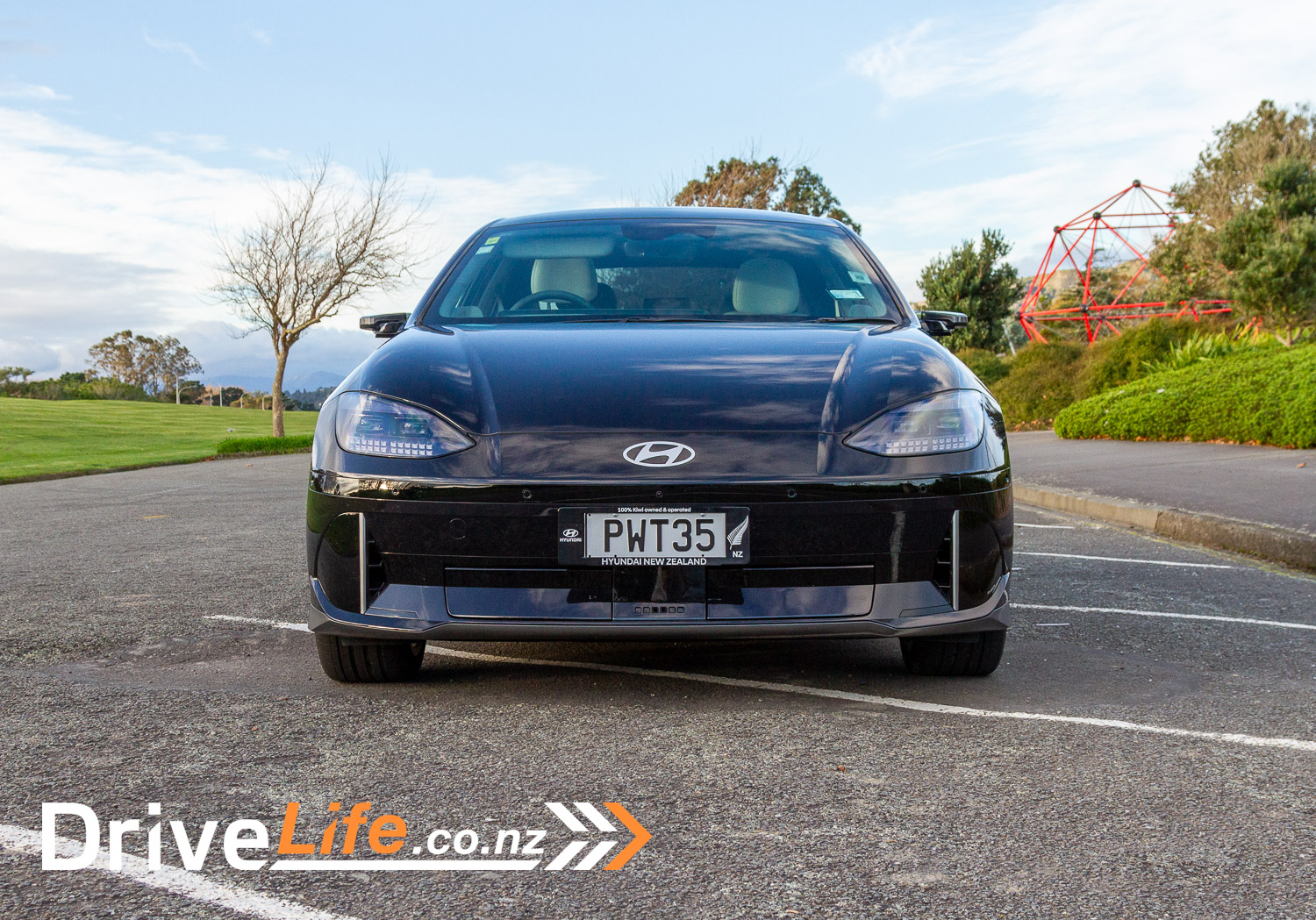
Driving around the city and suburbs was a pretty uneventful experience. The seats are great, steering nicely weighted and performance more than adequate. Wellington has pretty bad roads and they seem to be getting worse. The IONIQ 6 however had no problems dealing with them. It’s a heavy car, so this weight and a low centre of gravity probably help in controlling the body in situations like this, and even the large lowish-profile tyres hardly transmitted any shocks.
Two things really stuck out to me during these initial drives. The column type shift-by-wire system seems a bit of an outlier in the design. I’m not a fan of this position in general, but this one seems too fat in diameter for the car and inconsistent with respect to the elegance that is the rest of the interior. It felt clunky and unintuitive to use, with the infographics on the stalk not very clear. To me these graphics imply to use this like a traditional stalk, up and down as opposed to rotating the end to change drive mode.
The other thing that I never clicked with were the OLED screen mirrors. Little cameras on the exterior ( which help in reducing the drag coefficient to an impressive 0.21 ) show the rear view on a screen that is just inside the door. Muscle memory was still kicking in after a week and almost 900km and I continually found myself looking outside the window for the normal mirror position. If muscle memory is causing me to miss it when it is in a place almost in the norm, it makes me wonder why not put it in a position more practical for the driver as I’m sure over a longer time you would get used to it. Hyundai appears to be thinking about this as when you indicate the rear view appears in the instrument cluster in front of you. Clever use of tech there.
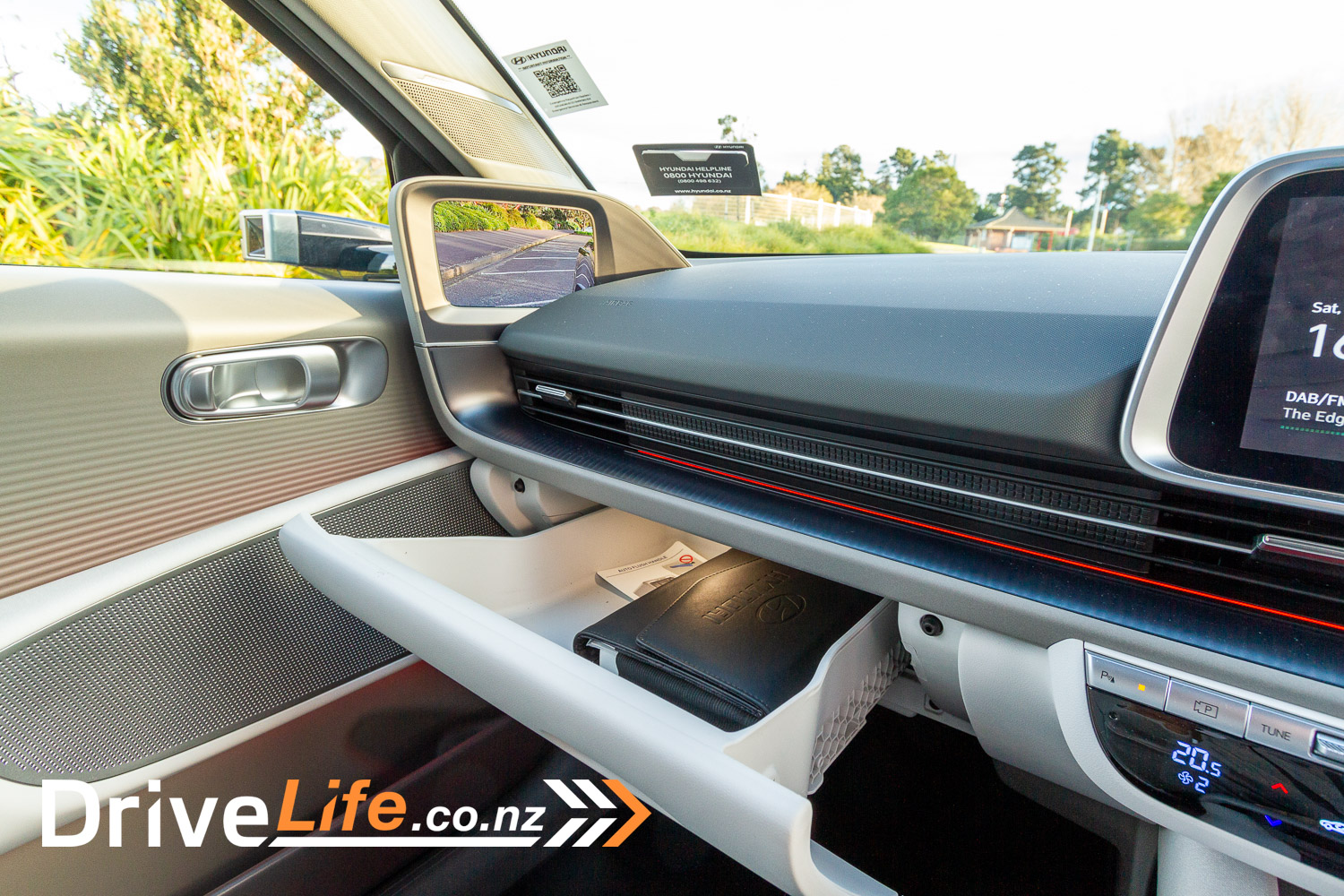
One thing I did notice about the rear view mirror system, is that the cameras seem very susceptible to water beads sitting on the lens during rain. When this happened the rear view screens were a blurred mess and not very helpful, maybe something to think about for refining the system.
The rest of the steering wheel controls are pretty straight forward. They are easily accessible by thumbs when driving as are the rear flappy paddles that alter the regenerative braking levels. The LCD screens in front are super clear and precise. The instrument cluster has a common outer theme with the centre section scrolling through relevant information for you, energy flow, tyre pressures, range etc. The outer sides however do change in certain circumstances such as using the indicators and when parking.
The most impressive thing however is the heads-up display. It is crisp and clear, both during day and night use, has good information that is relevant and is continually intelligently updating whilst not distracting the driver at all. I normally don’t like these, but this one was permanently turned on during our travels.
Being electric, the ride is basically silent. Around town tyre noise is minimal, and wind noise noticeably absent. A very pleasant experience.
After a week around town, it was off to Napier for the weekend, so time to charge. It was here that the realities of owning an electric car became apparent. Not owning a home charger, it was off to find a public charger, and apparently there were three nearby our apartment. The first proved a no-go, as you needed a RFID tag to open the plug and put your charge cable in. No worries, off to the second. Remember how I said the car is big? Well it is actually so big, that having the charge cable on the rear right quarter panel meant that it was physically impossible to get the car in a position where I could get it closer enough so the attached charge cable would reach. Two down, one to go…. ChargeNet tells me the third is free so off we go only to find in the 3 minute drive it is now occupied by a Leaf currently at 23% charge. After a 45 minute wait we plug in and start charging. Luckily I had the laptop with me and got a head start on editing the photos.
Armed with 85% battery, or 440km of theoretical range we headed to Napier. Should be easy right? It’s only 300km away.
Rolling into Waipukurau we had 61 km of range left, and our destination was still 50km away. Knowing there were no fast chargers near our destination, and not having a spare 40-something hrs to slow charge it at our destination, we reluctantly decided to spend some quality time at the Civic Centre carpark, while what my wife had nicknamed the spaceship got some juice.
This became a common trend on our journey and one that has left me firmly in the opinion that New Zealand is not equipped for electric vehicles yet. If you have charging at home and don’t go on long journeys then it is fine. But for a lifestyle that predominantly revolves around minimal city driving and long trips, then forget it. When I drive I want to get in the car and go with the only stop either a pre-planned one for shopping, food or to visit something. Having to stop every 300km, for the best part of an hour to recharge makes no sense and adds considerable travel time to your journey.
The other issue we ran into, other than range, was the accessibility of fast charging. Looking at both apps I had downloaded told me Napier had public chargers in the centre of town. We rocked up to them only to find they were out of order. A trip to the local ice cream parlour, where the owner was quick to admire the IONIQ 6 having just purchased an IONIQ 5 himself, confirmed these were the only “fast” chargers in town. One of the local supermarkets offered free charging and had an impressive number of stations, but you would have to do a monthly shop for a family of 10 to get any useful range from the 7kW feed. Their competitor a little way down the road in the suburbs had one fast charger and it was priced accordingly to take advantage of the supply/demand equation at approximately twice the price of all others.
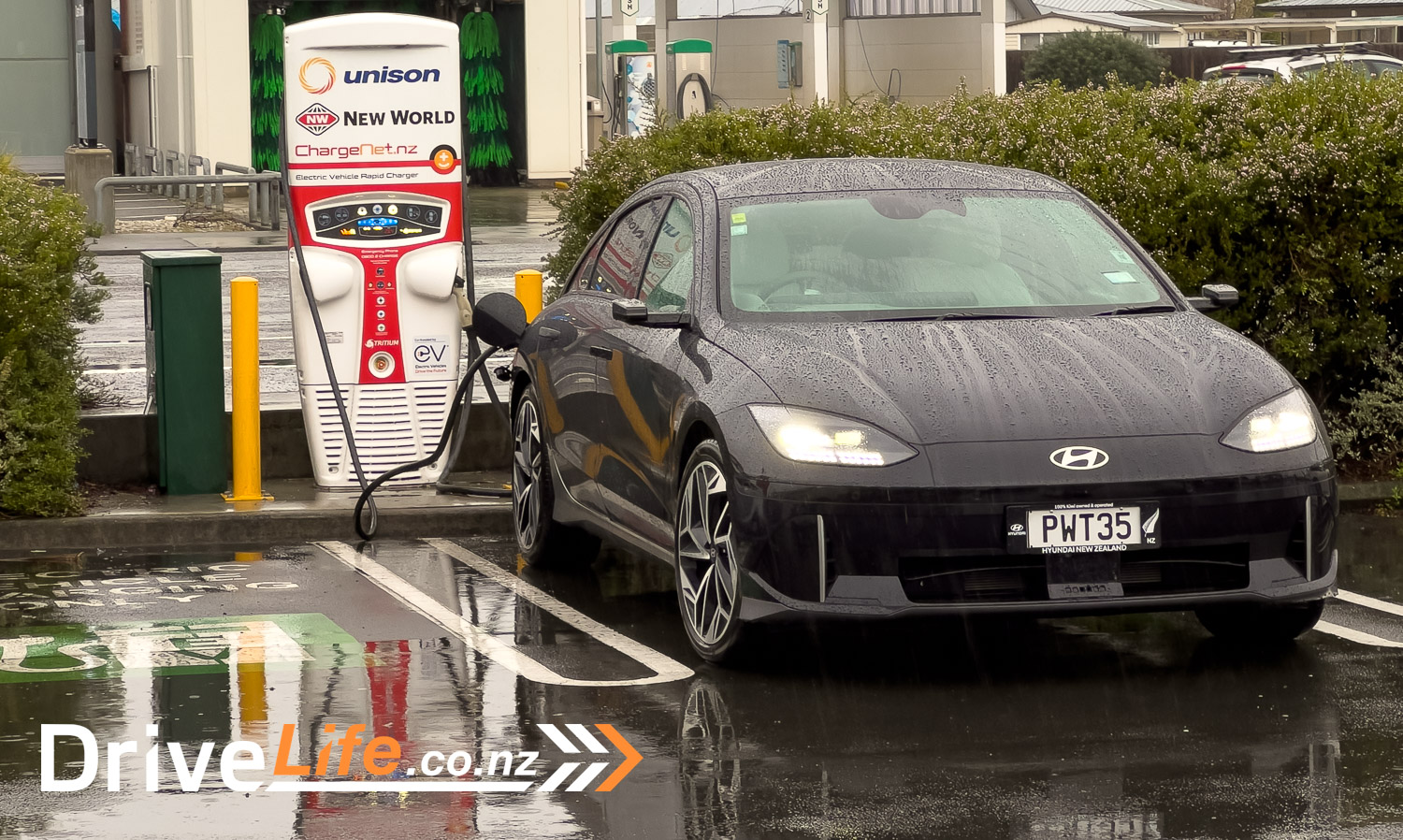
By my calculations, on the open road a full charge should give 373km, this is based on 67% battery usage that gave us 250km, and the 20.7-20.9 kW/100km I was consistently seeing on the trip meter. Quite disappointing when it is advertised as 519km. When I returned the vehicle, it had approximately 5,000km on the clock, and was showing an average energy usage of 20.5kW/100km, so although my usage was a bit higher, It is still within the current long-term average for the vehicle. To achieve the 519km range with a 77.4kW battery would require a usage of 14.9kW/100km, a number which I never even saw an instantaneous energy consumption figure of.
Despite the frustrations, once you actually concentrate on the physical driving experience, the IONIQ 6 is really good.
As per the around town trips, on a long trip noise is practically non-existent, with only a minimal amount of tyre and wind noise coming through. The seats were super comfortable and the cabin had plenty of space. As opposed to city driving, we spent more time playing with the infotainment, cruise control, and various other goodies within the vehicle.
I’m normally pretty averse to systems that take control away from the driver. However, the Lane Following Assist and Lane Keep Assist (LFA / LKA) worked really well. Holding on the steering wheel with virtually no pressure I could feel the subtle corrections the vehicle was making and it perfectly kept me within the lanes. Likewise, the smart cruise control was one of the most accurate I have tried, keeping the vehicle at a constant speed over rolling and windy terrain, without wavering at all. When travelling through different speed zones it picked them up quickly, slowed us down to the new limit and accelerated again when required. It was all pretty effortless and easy from a driving point of view.
I didn’t get a chance to test all the collision avoidance systems, but judging by the accuracy of Hyundai’s current object detection system, I have no doubt they will work well.
Performance-wise, the IONIQ 6 does not feel like a heavy car once on the open road. It is well-planted and controls the body well, but is also nimble when changing direction. It’s not going to win a slalom gymkhana, but that’s not its aim. The steering is light but very precise and has good feedback through the wheel. It’s more on the luxury car end of the scale than a purist’s driving car though.
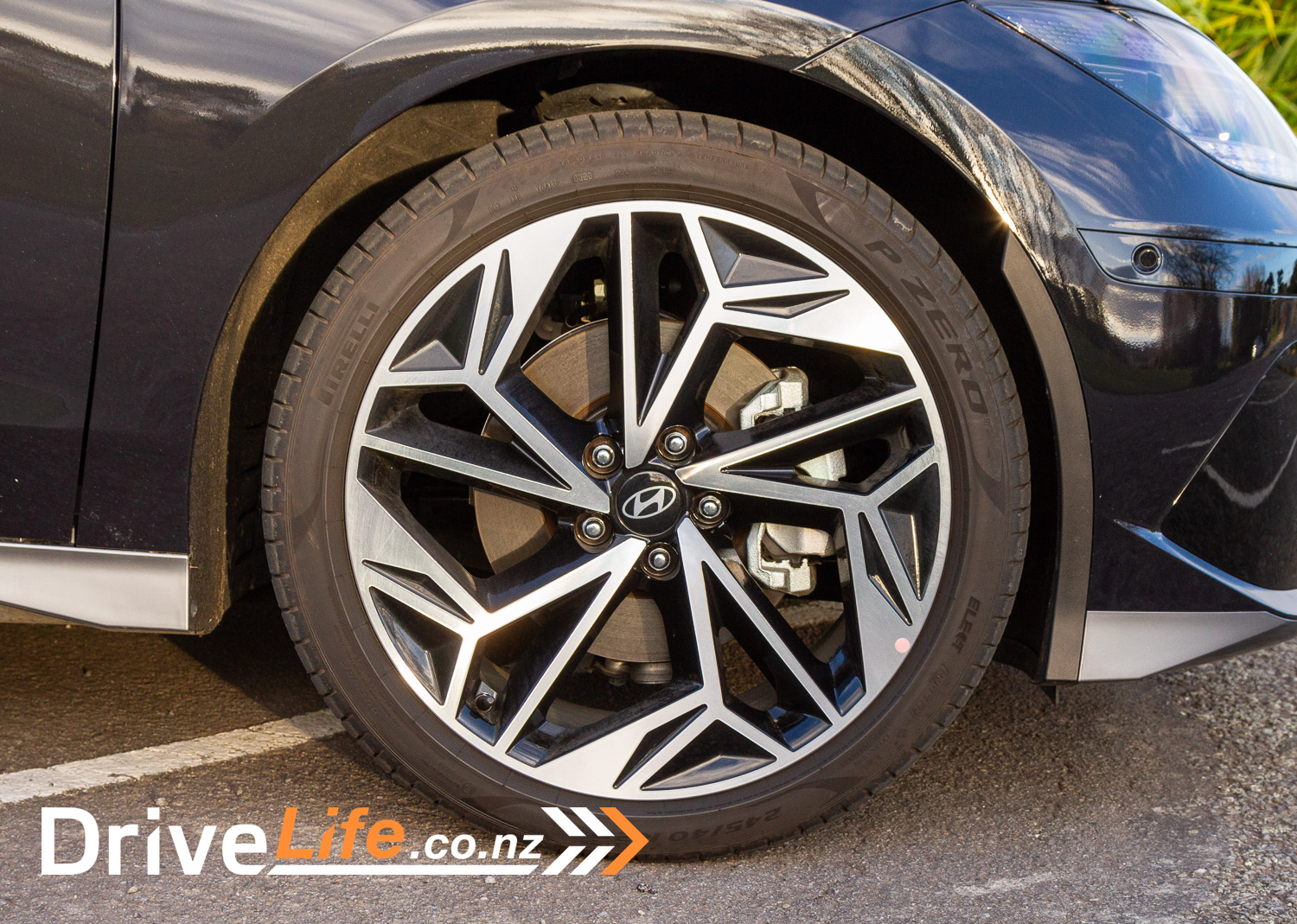
In terms of driving mode, you have the standard Normal, Eco and Sport. We spent most of our time in Normal, but did try the others. Eco mode will put the vehicle in RWD only and reduce max power to approximately 225kW, though this does not seem to give much more than 6-7% increase in efficiency. Sport mode gives you sharper steering, and really lets the performance out. From a standing start this mode was really impressive. I didn’t accurately time it, but would bet the 0-100km time of 5.1s advertised is pretty much bang on.
Instantaneous 600Nm of torque and AWD certainly put a smile on the face of my parents in the back seat, however watching the energy usage during these experiments will not. There are three levels of regenerative braking control that you can select, activated by the steering wheel-mounted paddles. Again these offer a wide range, and I found myself using the middle range setting as the go-to.
Sound throughout the cabin is great, and we had no trouble hooking up our phones with Bluetooth. I could however not get the Apple CarPlay to work at all, despite trying all the available USB ports (well done Hyundai for giving it heaps of these) and must say I was disappointed that a car in this price brand does not offer wireless CarPlay. Phone integration for making calls worked well and was easy to set up.
During our time in the IONIQ 6, we managed 20.7kW/100km. A very surprising and disappointing result. The weather was not the warmest, and I am aware of the effects this has on range, but the discrepancy in advertised and actual was just too large.
FRED’S POINT OF VIEW
After going to the launch of the Ioniq 6 , I was very much looking forward to taking this test car on a 900km road trip with my family. Yep, we’re heading away for the long weekend, four adults and guess what? Not in an SUV.
I was determined to show you don’t have to have an SUV to go on holiday. After a couple of days commuting, I loaded up the boot of the Ioniq 6 with all our stuff. Truth be known, I didn’t realise we’d have so much ‘stuff’ for three nights away. To say the boot was full is pretty accurate, with every last inch of space used up.
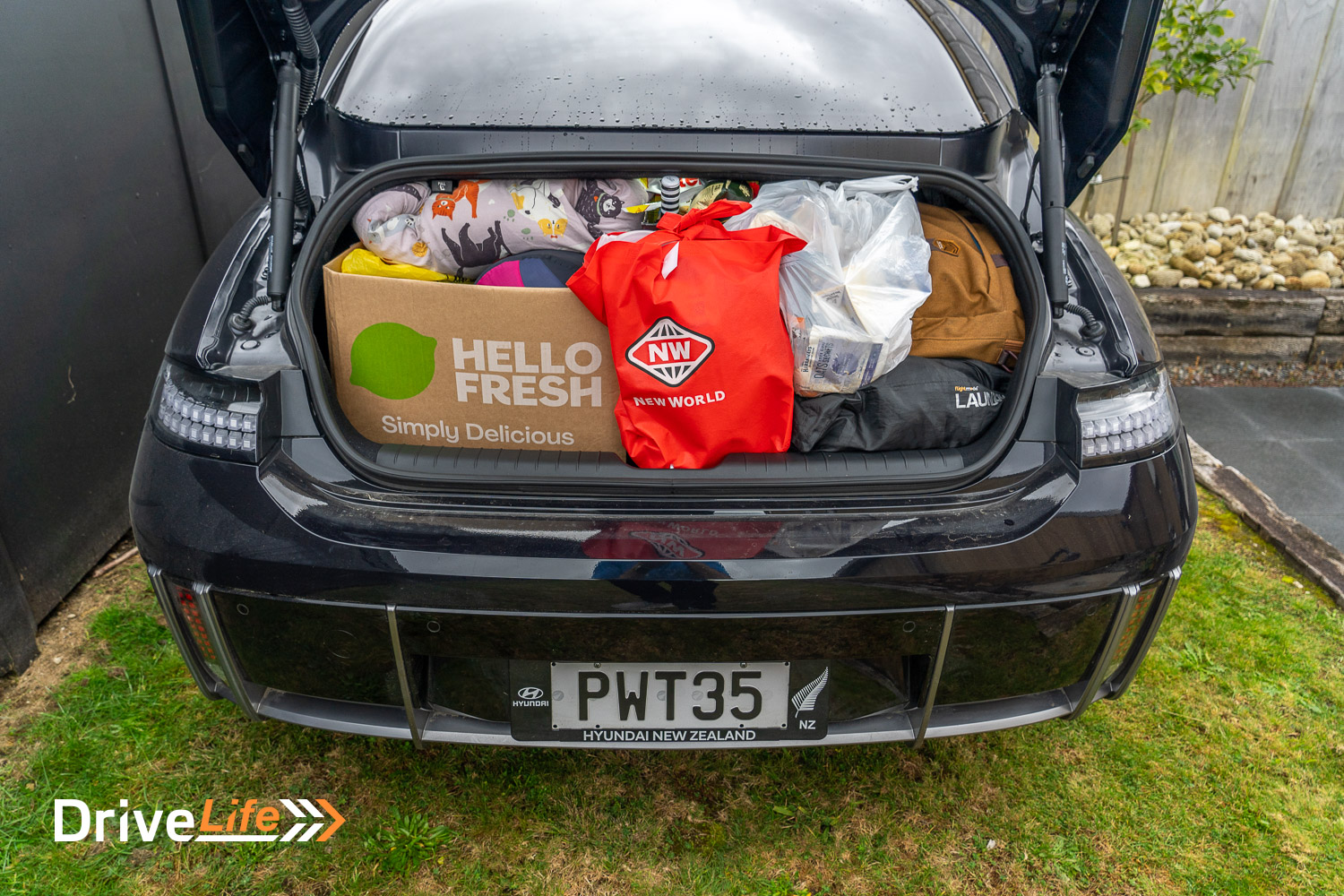
But it fitted in, although there were some pillows and other things on the back seat with my two grown kids. No real issue there, as there’s a huge amount of room in the back of this car, and the legroom is outstanding.
We hit the road and one of an EV’s worst enemies joined us: heavy rain. I knew this would suck our range down, but not much could be done about that. Heavy traffic everywhere too, but this was a long weekend so totally expected. Still, the Ioniq 6 is a great place to be on a roadie. It’s super quiet, with almost no road noise, very low levels of wind noise, and tyre noise only evident on coarse-chip seal. It really is pretty relaxing.
Part of that relaxing includes the Ioniq 6’s adaptive cruise control; it’s one of the best, very smooth and just works the way you’d expect it to. Set and forget.
While there seems to be gallons of space in the Ioniq 6, we did use it all up including that huge area under the centre console. This massive space can take sweatshirts, cameras, hats – all at the same time. A very usable spot.
We got to Bulls and decided we’d top the car up while having dinner, and then that’d be enough charge to get us to our location, Whareroa Village, on the western shores of Lake Taupo. In thirty minutes on the hypercharger, the car went from 25 to 92% battery charge, at a cost of $32. That gave us a range of 365km. The battery wasn’t full when we left Wellington, but that thirty minutes was just enough time to eat.
I did note that even though we were plugged into a 300kW Hypercharger and the Ioniq 6 is supposed to take up to 300kW (actually up to 350kW, says Hyundai), the most I saw going in was 152kW. That’s way short of the maximum. We’d expect the charge to drop off as the battery charges, but even at 25%, ‘only’ 152kW was going in.
Heading north again, we got to the Desert Road and the twisties that goes along with it. Thankfully, no slow drivers in sight so we got a clear run through to test the car out some. I must say, even loaded up with four adult passengers and the boot totally full, the car does handle quite well. It was an interesting comparison with the Ford Mustang Mach-E , where while that car handled well too, you could often feel its weight when pushing on. I didn’t get that feeling in the Ioniq 6.
It was nice to see that the car’s performance isn’t too affected by its weight. As mentioned, we were full up and yet even in Eco mode, the car fair hummed along when I needed it to. Another revelation on that drive North was the car’s adaptive LED headlights; they are outstanding, with a huge spread of light and having them adaptive just adds to their performance.
I think if there was a single negative on our trip, it was having to plug in a cable to use Apple CarPlay. This is a small gripe, but I still find it weird that we have this space-age car, all new and shiny, and yet CarPlay is via cable? This is already old school.
Arriving at our destination after 5.5 hours of driving, it was nice to note that seat comfort is excellent; no aches, pains or anything else. Charging the car up was too easy – I backed it down the lawn, and plugged it in. Only 6 amps of power would be going in, but that’s still around 8km/hour of charge being put into the battery bank.

The next day, we headed to Taupo to Timberline Racing Siberian Huskies. We went via the Western Access Road, as it’s far more deserted than going via SH1. For this leg of our trip, I slipped the Ioniq 6 into Eco mode, meaning mostly RWD. It’s still impressive how it can take a corner using RWD; the grip is still excellent, and there’s almost no noticeable loss of traction or handling at average speeds.
We arrived at Timberline Racing Siberian Huskies, and did the tour. This is where you learn all about Huskies, watch them pull a 4-wheel farm bike around an 800m track for three laps, and then of course you get to play with them.
For only around $35pp, this is great value as you end up spending a few hours at the property, and it’s all pretty interesting stuff. Playing with 17 Huskies is just the cream on the cake. Definitely recommended. I had to laugh as we piled into the Ioniq 6, and the Siberian Huskies guy asked, “is that a Porsche?”. Not quite, but definitely looks like one. I did see that there were 6 cars full of tourists like us at the Huskies place, and 5 of them were SUVs. More evidence that we apparently love our SUVs.
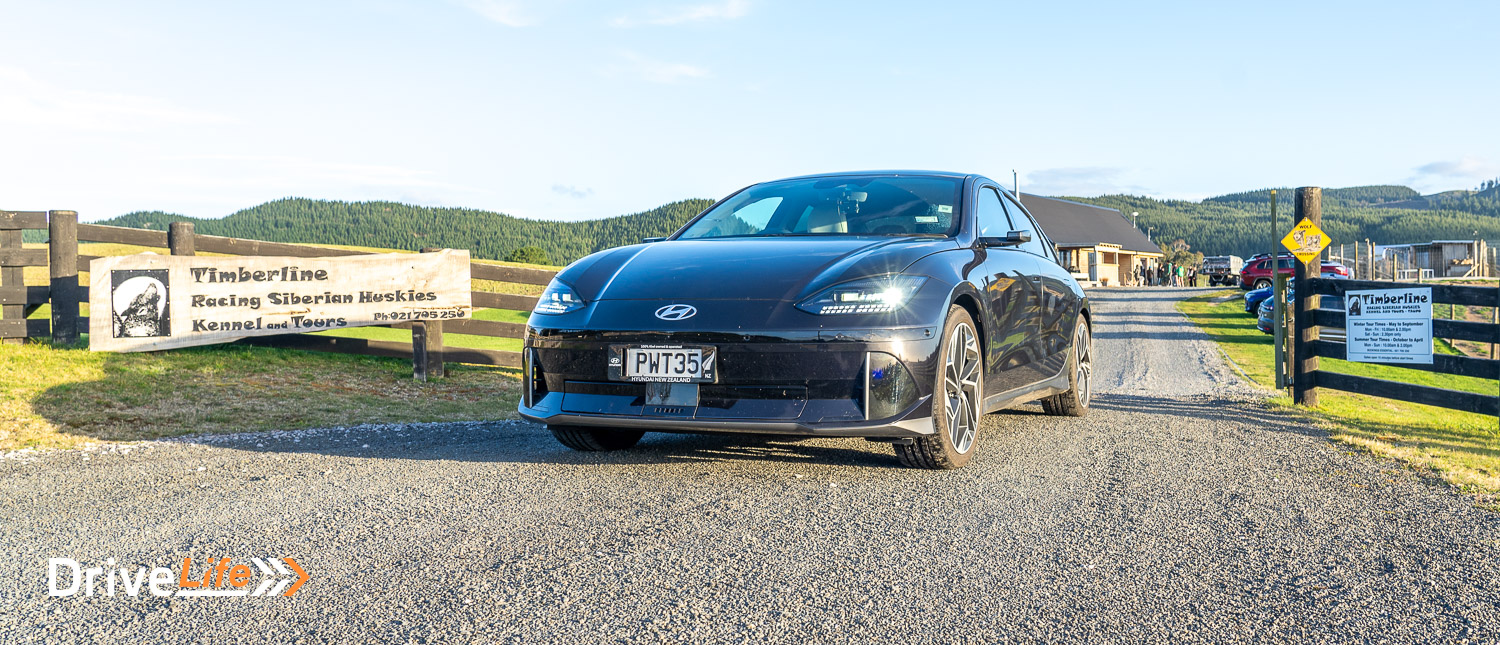
After the tour, we headed into Taupo and plugged into the hypercharger there, for the first time ever (for me) all four chargers were available. In 23 minutes, over coffee, the car went from 16-80% charged at a cost of $45. Not cheap, but still cheaper than petrol.
On the Sunday, it was time to load up again and hit the road. After charging the car overnight at the BNB, it sat on 92% charge, with a range of 352km. Our drive home was 287km, so surely we would make it? I stuck the car into Eco mode to give it the best advantage but had a feeling the dark clouds would mean a wet drive and less range.
A few more things to note as we drove home. While Ford’s Mustang Mach-E only has an on/off setting for regen, the Ioniq 6 has ‘proper’ regen paddles, meaning you can have no regen, or increase it until you get to the i-Pedal setting, a.k.a one-pedal driving. This is so easy to use, and it does make for an easier drive, as you can adjust the regen while driving to suit the conditions of traffic, corners etc. It’s great, and it works perfectly.
The digital mirrors took me a while to get used to. By the return trip, my head was flicking to the screens instantly, and that was a bonus as I know Matt struggled with these. I still wonder about those mirrors; yes, they are more aerodynamic so you use a little less energy, but it does feel like we are solving a problem that really isn’t there.
I guess the elephant in the room is the design. Some people almost hate it, but honestly in the flesh, it isn’t too bad. It’s out there, I’ll give you that, but it’s not offensive – to me, anyway. I don’t mind it, and the whale-tailish rear is actually pretty nice.
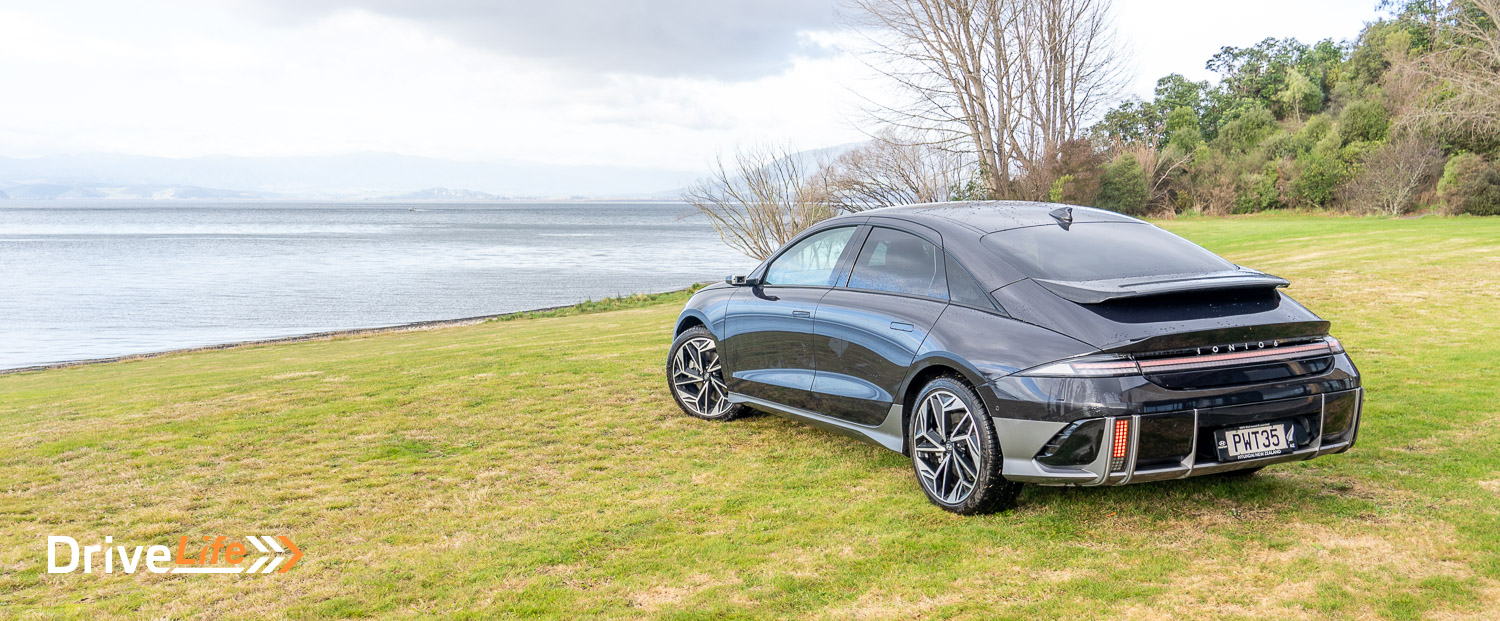
So, how did we go on range on the drive home? As we neared Bulls (and a Hypercharger) I did a quick check. We had 140km left to drive, and 130km range. If I was on my own I’d have a crack at it, but my wife chimed in with a “no way”. So I went to plug in, but all 3 chargers there were busy. We had lunch, and then went and checked again – still busy. So we hit the road and went to Levin, sat for 10 minutes to top up enough to get home.
Our total energy consumption for that 287km trip home was 20.1kWh/100km. With the weight in the car, the weight of the car and the wet weather we encountered, that’s pretty much what I’d expect the result to be.
For me, I very much enjoyed driving the Ioniq 6. It does show you don’t necessarily need an SUV, and the handling is definitely better than one. Other than the range of the car vs. cost, overall the Hyundai Ioniq 6 is an excellent car.
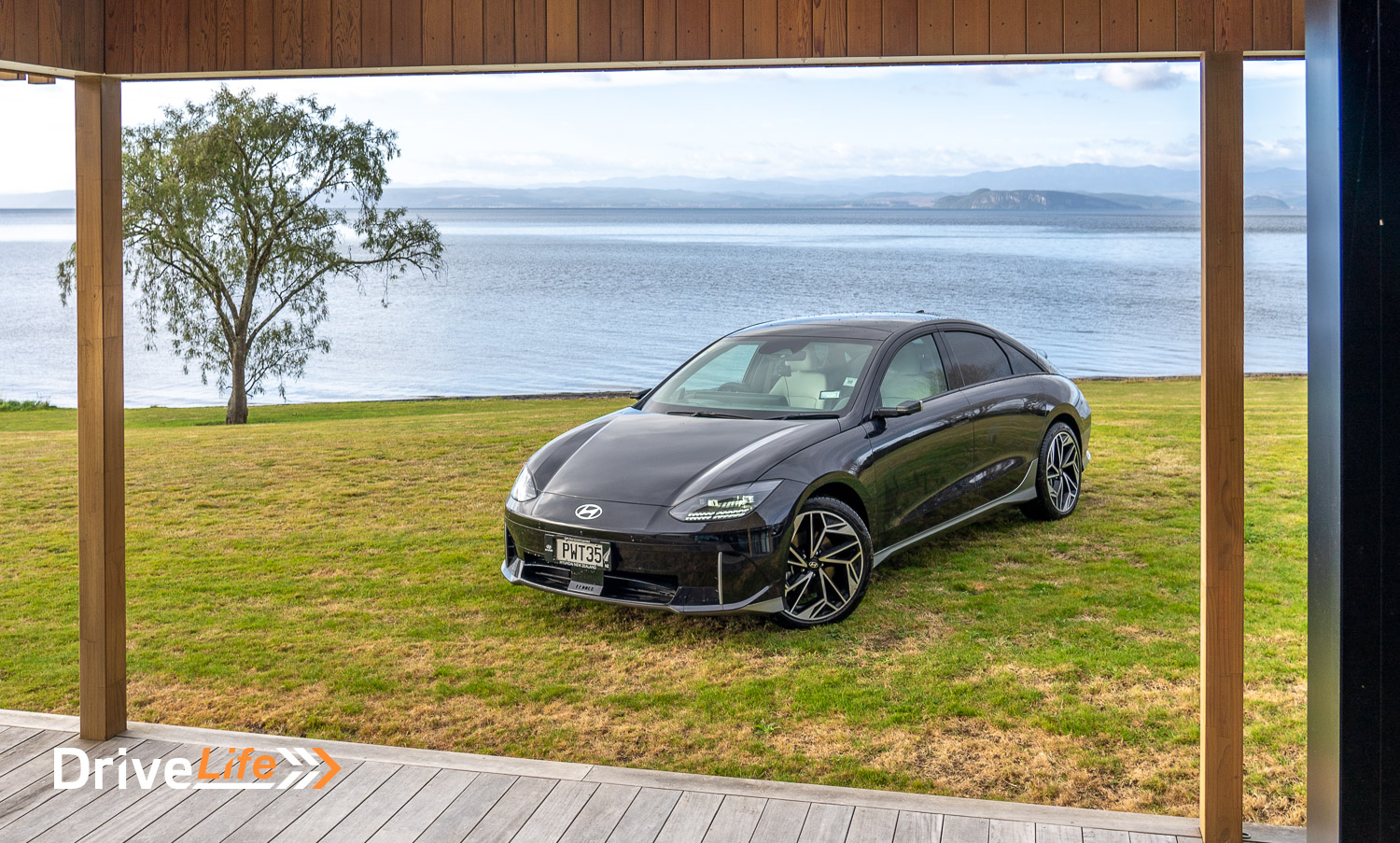
2023 Hyundai IONIQ 6 Limited AWD – Specifications
| Vehicle Type | Electric Sedan |
| Starting Price | $124,990 |
| Price as Tested | $125,852.50 |
| Engine | Dual Permanent Magnet Synchronous Motors |
| Power, Torque kW/Nm | 239 / 605 |
| Transmission | HTRAC Automatic All-Wheel Drive |
| Spare Wheel | None |
| Kerb Weight, Kg | 2,020 |
| Length x Width x Height mm | 4855 x 1880 x 1495 |
| Boot Space / Cargo Capacity, Litres | 423 |
| Battery capacity, kW | 77.4 |
| Energy Economy, kWh/100km | Advertised Spec – Combined – 16.9 Real-World Test – Combined – 20.7 Low Usage: 6-10 / Medium Usage 11-19 / High Usage 19+ |
| Towing Capacity Kg, unbraked/braked | 750 / 1,500 |
| Turning circle metres | 11.8 Small: 6-10m / Medium 10-12m / Large 12m+ |
| Warranty | 10 Year / 200,000km anti perforation corrosion body warranty 8 year / 160,000km high voltage battery warranty 3 year / 100,000km mechanical warranty 3 year / 100,000km roadside assistance package |
| Safety information | ANCAP Rating – 5 stars Rightcar.govt.nz – PWT35 5 Stars |
Have you enjoyed this review? Be sure to join our monthly email newsletter list so you don’t miss a single car review!


